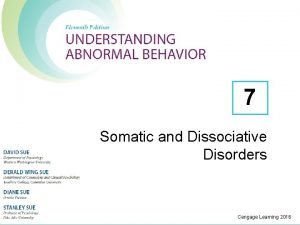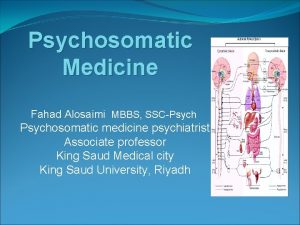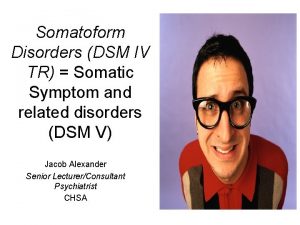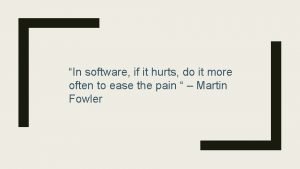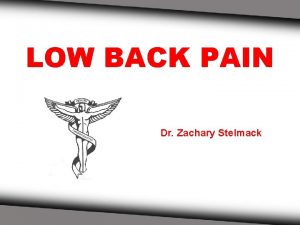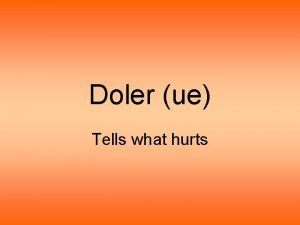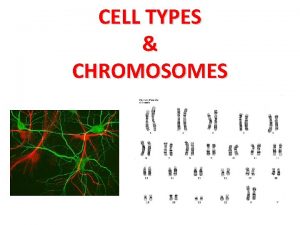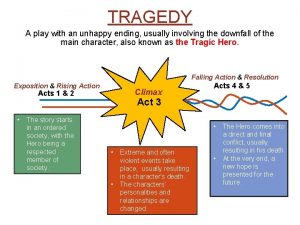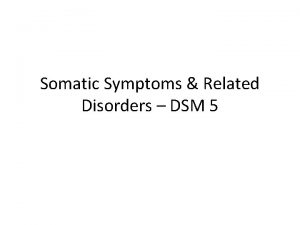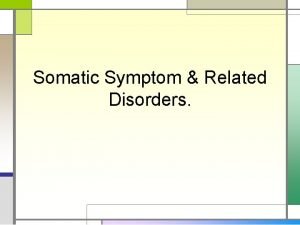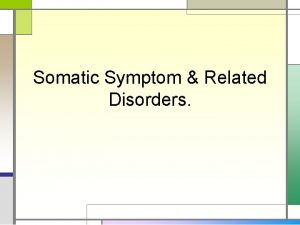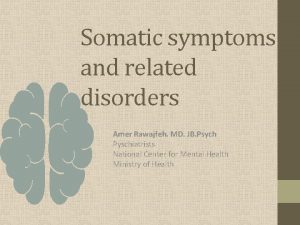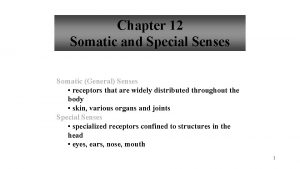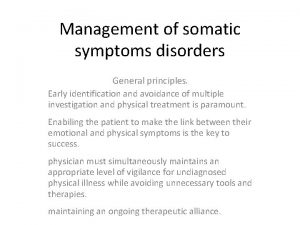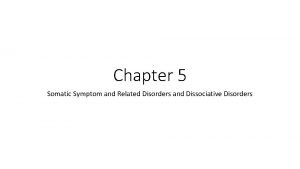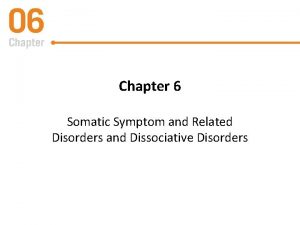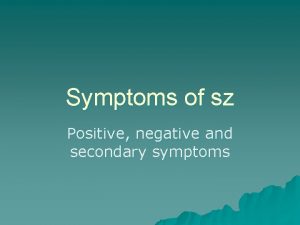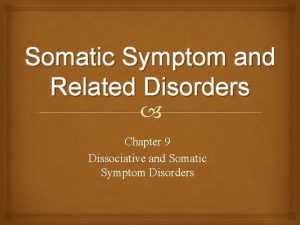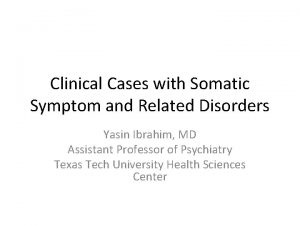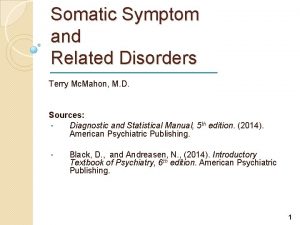Everything Hurts Dealing with Somatic Symptoms and Related















































- Slides: 47

Everything Hurts: Dealing with Somatic Symptoms and Related Disorders Cerrone Cohen, MD

“I can’t swallow” “I blackout every day” “I’m weak” “I hurt everywhere” “My tongue tingles” “Burning all over my body” “My arms go numb” “I’m always dizzy”

Objectives Identify 3 separate disorders that have chronic somatic symptoms as a core feature Discuss a framework for patient and provider well being while treating patients with somatic symptoms Describes an interdisciplinary approach to care or patients with multiple unexplained symptoms

Classically Somatic Disorders = Medically Unexplained Symptoms with a psychiatric origin

How They Feel

How You Feel

Everybody Loses

Up to 40% of patients seen in primary care have symptoms without a clear organic etiology • Medically unexplained symptoms in primary care. J Clin Psychiatry. 1998; 59 Suppl 20: 15 -21. Lippincott’s primary care psychiatry. 2009. Medically Unexplained symptoms

Patients with somatization account for 2 x the medical expenses as those without • Medically unexplained symptoms in primary care. J Clin Psychiatry. 1998; 59 Suppl 20: 15 -21. Lippincott’s primary care psychiatry. 2009. Medically Unexplained symptoms

Having unexplained physical complaints does not mean that a patient has a psychiatric disorder

Somatic Disorders =/ Medically Unexplained Symptoms

Somatic Symptoms and Related Disorders Illness Anxiety Disorder Somatic Symptom Disorder Factious Disorder Conversion Disorder (functional neurologic symptom disorder)

Somatic Symptoms and Related Disorders Illness Anxiety Disorder Somatic Symptom Disorder Factious Disorder Conversion Disorder (functional neurologic symptom disorder)

Illness Anxiety Disorder Core Feature: Preoccupation with acquiring or having a serious illness

Illness Anxiety Disorder § Somatic symptoms are not present, or are mild § High level of anxiety about health § Excessive health related behaviors or exhibits maladaptive avoidance § Present for greater than 6 months


Somatic Symptoms and Related Disorders Illness Anxiety Disorder Somatic Symptom Disorder Factious Disorder Conversion Disorder (functional neurologic symptom disorder)

Somatic Symptom Disorder Core Feature: Distressing somatic symptoms and abnormal thoughts, feeling, and behaviors in response

Individual distress is authentic whether or not it is medically explained

Somatic Symptom Disorder 1. One or more somatic symptoms that are distressing or result in significant disruption of daily life. 2. Excessive thoughts, feelings, or behavior related to sx or associated health concerns manifesting as at least 1 of the following: -High level of heath-related anxiety -Disproportionate concern about the medical seriousness of one's symptoms -Excessive time and energy devoted to these symptoms or health concerns 3. The state of being symptomatic lasts more than 6 months.

Somatic Symptoms and Related Disorders Illness Anxiety Disorder Somatic Symptom Disorder Factious Disorder Conversion Disorder (functional neurologic symptom disorder)

Factitious Disorder (Munchausen) Core Feature: Deceptively falsifying of medical or psychological symptoms in yourself or someone else

Factitious Disorder (munchausen) § Falsification of physical or psychological sx, or induction of injury or disease associated with deception § Individual presents self to others as ill, injured, or impaired § Deception is present in absence of obvious external rewards § “Imposed on Self” or “Imposed on Another”


Somatic Symptoms and Related Disorders Illness Anxiety Disorder Somatic Symptom Disorder Factious Disorder Conversion Disorder (functional neurologic symptom disorder)

Conversion Disorder (functional neurological symptoms disorder) Core Feature: Altered motor or sensory function that is inconsistent with a medical diagnosis

Conversion Disorder (functional neurologic symptoms disorder) § One or more symptoms of altered voluntary motor or sensory function § Not consistent with a medical diagnosis § Causes some sort of impairment in function, significant, distress, or requires medical evaluation

Conversion Disorder (functional neurologic symptoms disorder) § § § Non-epileptic seizures Partial paralysis/weakness Tremor or gait problems Loss of sight Difficulty swallowing


Somatic Symptoms and Related Disorders Illness Anxiety Disorder Somatic Symptom Disorder Factious Disorder Conversion Disorder (functional neurologic symptom disorder)

How do these develop? • Biological Factors: increased sensitivity to pain • Social: early traumatic experiences • Psychological: learning, attention obtained from illness, or lack of reinforcement of nonsomatic expressions of distress

Treatment CARE MD A mnemonic for caring for patients with chronic somatic symptoms

Treatment SCARE MD A mnemonic for caring for patients with chronic somatic symptoms

Treatment MD CARES A mnemonic for caring for patients with chronic somatic symptoms

Mind-body Connection Do No Harm Collaboration Assessment Regular Visits Empathy Set Realistic Goals

Collaboration

Assessment 1. Physical Symptoms 2. Psychological Symptoms 3. Prior Work up

Regular Visits Regular visits can reduce costs by 50% Smith et al. Psychiatric Consultation in Somatization Disorder. N Engl J Med 1986; 314: 1407 -141

Regular Visits Necessary due to the volume and intensity of symptoms in the patient and the provider Smith et al. Psychiatric Consultation in Somatization Disorder. N Engl J Med 1986; 314: 1407 -141

Regular Visits • Focused Exam • Focused check-in on symptoms • Introduce Mind-body Connection

Empathy Patients will not let you care for them, unless they feel that you care about them

Mind-Body Connection • Symptom logs • Wonder out loud • Avoid statements that assume that symptoms are not real

Every one of us has a somatic component to our emotional lives

Do No Harm Sometimes less is more

Set Realistic Goals • • Reduction in ER visits or Hospitalizations Reduction in Opiate Dose Improvement in Pain Decreased expense to the Patient

Case 1 A 25 yo married male comes into clinic complaining of warmth in his groin and bumps on his scrotum. He reports that symptoms began after an erotic massage he received at a massage parlor. Symptoms come and go. He is concerned that he may have contracted an STD from the massage though there was no intercourse. He has been seen 3 times in the past 8 weeks for the same complaint and repeated STD testing is normal. He was referred to urology who found a varicocele which was surgically repaired. He underwent repeat imaging which now shows a small varicocele on the opposite side. He presents today asking for another HIV test.

Questions?
 Dissociative
Dissociative Somatic symptoms
Somatic symptoms Primary gain
Primary gain Cramps before period
Cramps before period Physical fitness two types
Physical fitness two types Skills related
Skills related Hurts just a little bit scale
Hurts just a little bit scale Not heavy
Not heavy If it hurts do it more often
If it hurts do it more often Low back rom
Low back rom übersetzung everybody hurts
übersetzung everybody hurts Dr brendon aubrey
Dr brendon aubrey How to use doler
How to use doler Chapter 5 lesson 1 dealing with anxiety and depression
Chapter 5 lesson 1 dealing with anxiety and depression Chapter 5 lesson 1 dealing with anxiety and depression
Chapter 5 lesson 1 dealing with anxiety and depression Chapter 10 somatic and special senses
Chapter 10 somatic and special senses Chapter 29 somatic symptom and dissociative disorders
Chapter 29 somatic symptom and dissociative disorders Diploid cell
Diploid cell What is the difference between somatic and special senses
What is the difference between somatic and special senses Nervous system main division
Nervous system main division Autonomic receptors
Autonomic receptors Define forensic pathology
Define forensic pathology Somatic senses
Somatic senses Branch of linguistics dealing with meaning
Branch of linguistics dealing with meaning Abiotic factors
Abiotic factors Section 2 dealing with other nations
Section 2 dealing with other nations Dealing with call center stress
Dealing with call center stress Dealing with competition in marketing
Dealing with competition in marketing It is genre of speculative fiction dealing with imaginative
It is genre of speculative fiction dealing with imaginative Dealing with competition marketing management
Dealing with competition marketing management Unit 1 dealing with incoming calls
Unit 1 dealing with incoming calls Dealing with anger in the bible
Dealing with anger in the bible Dealing successfully with difficult changes in your life.
Dealing successfully with difficult changes in your life. Lexical items
Lexical items Referred to a play with an unhappy ending.
Referred to a play with an unhappy ending. Dealing with unstructured data
Dealing with unstructured data Aegisoft
Aegisoft Dealing with unstructured data
Dealing with unstructured data The branch of zoology dealing with insects
The branch of zoology dealing with insects The branch of zoology dealing with insects
The branch of zoology dealing with insects Dealing with challenging patients
Dealing with challenging patients Dealing successfully with difficult changes in your life
Dealing successfully with difficult changes in your life Dealing with unstructured data
Dealing with unstructured data Insider dealing
Insider dealing Resolve hrs
Resolve hrs 3p fair dealing
3p fair dealing Dealing synoynm
Dealing synoynm Objection prix addition soustraction
Objection prix addition soustraction
